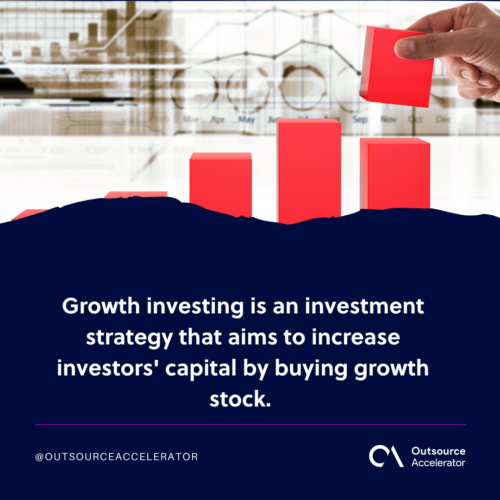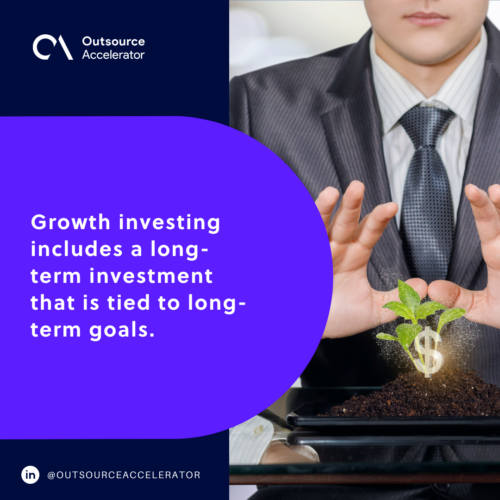Growth investing
Definition
What is growth investing?
Growth investing is an investment strategy that aims to increase investors’ capital by buying growth stock.
As a capital allocation strategy, investors tend to do growth investing in startups or small companies that are expected to grow in the overall market over the years. These are companies that show the potential to provide exceedingly high returns.
Further, these companies do not pay dividends to their shareholders since all earnings are reinvested back into the company to generate more earnings or revenue.
However, growth investing is considered a high-risk investment since some growth stocks tend to fall due to past-face industries, usually because of technological advancement.
That said, growth investing has been experiencing a significant fall as of May 2022. The growth stock market, as represented by Russell 1000 Growth Index, provided a total return of -8.9% over the past 12 months.
Inflation, supply chain constraints, and other macroeconomic factors are the reason why growth stocks have been performing low market numbers.

How does growth investing work?
The idea of growth investing is investors look for profit through capital appreciation rather than dividends or interest. A potential growth through earnings and revenues leads to higher stock prices in the future.
According to Forbes, the best stock growth in the year 2022 include Alphabet Inc, Halliburton Co., Meta Platform, Starbucks, and Amazon, among others.
Growth investors often maximize their capital gains, which is why it is sometimes considered an offensive investment strategy.
The offensive investment strategy in growth investing is high-risk yet high-reward, which often takes advantage of the bull market. In contrast, a defensive investment strategy is designed to protect growth investors from a significant loss.
What is the difference between growth investing and value investing?
Growth investing is far distinct from value investing. In the former, growth investors are highly attracted to companies that are expected to grow either profits or revenues.
On the other hand, value investing involves seeking a company that appears to be underperforming or undervalued.
Whatever the case, there is no considered the best investment strategy between growth and value investing. Some studies have shown that value investing growth investing over an extended period of time.
Types of growth investment
Growth investing includes a long-term investment that is tied to long-term goals. These are popular types of growth investments.
Growth funds
Growth funds are the mutual funds or exchange-traded funds (ETF) that include stocks from a variety of companies with “above-average growth.” These are high-risk and high-reward capital appreciation, but they may offer many advantages of growth investing.
Small-cap stocks
Small-cap is a shortened version of “small market capitalization,” typically with a market cap between $300 million and $2 billion. Firms in small-cap are often young companies that have potential growth.
Technology and healthcare stocks
Companies in technology and healthcare stocks offer technological advancements and innovation, which are really good for an investor’s portfolio. Companies in this sector can achieve growth over a short period.
Speculative investment
This is a high-risk growth investing strategy, which often receives a good return on capital but might be destructive as it may cause loss of all the initial investment. The speculative investment includes penny stocks, futures and options trading, oil and gas drilling projects, and real estate projects.

What are the factors to consider in growth investing?
Growth investing requires no formula as it is based on objective and subjective factors as well as personal judgment. Here are the several key factors that investors consider in engaging in growth investing.
Historical growth
Growth investors look for the growth of the company, usually with an excellent track record of profits and earnings over the previous five to 10 years. If a company displays significant growth, investors are most likely to invest in them since they are more advantageous.
Profit margins
Investors consider a pretax profit margin first before engaging in growth investing. Pretax profit margin is a vital metric to consider, which determines if a company has grown in sales but less in earnings meaning there is a problem in managing costs and revenues.
That said, companies that appear to be like that are not good growth candidates.
Return on equity (ROE)
Return on equity measures how much a company generates profits. ROE is calculated by dividing net income by the total equity of the shareholders. A stable ROE indicates that the company has good operations.
The risks of growth investing
Growth investing is more beneficial for investors. It offers high returns to investors as well as a high risk-to-reward ratio and returns on investment.
However, there is a high risk along with it, such as margin of safety, mainly because funds are more focused on growth rather than the valuation of the stocks. This includes focusing on the blue-chip, stalwart, market leader, or small-cap.
Another disadvantage of growth investing is that when there is an economic recession, this strategy can’t help retain the capital of the investment.







 Independent
Independent




